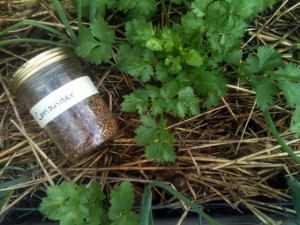
- Home grown coriander seeds with its offspring, a clump of cilantro.
A favorite seasoning of tropical cuisines ought to grow happily in summer but Cilantro just doesn’t. It much prefers the cold. How can an herb featured in Mexican and Southeast Asian dishes have such an aversion to heat? I ponder this mystery each year as tomato season approaches and we are challenged to ensure a steady supply of that distinctive, love-it-or-hate-it flavor for our summer salsas and salads.
Cilantro, the Mexican name for the leaves of the coriander plant, is related to parsley, and like its cousin, grows best in chilly temperatures. But even more than parsley, I’ve found cilantro to be a super-hardy crop for over-wintering. What a surprise!
Unlike parsley, which will produce juicy leaves for a whole season before going to seed the second year, cilantro is prone to bolting at the first sign of heat or stress. Cool temperatures keep cilantro plants in the leaf stage for a prolonged period of harvest.  But in summer the plant barely emerges before shifting its energy from making leaves to flowering, eventually producing the round, papery-skinned coriander seeds we all know from the spice cabinet.
Given that challenge, here are my strategies for keeping a steady supply of cilantro flavor all summer.
1. Keep planting all season. Find moist, shady nooks and crannies to plant cilantro seeds – behind a bean pole or under the broccoli plants – every week or two. The cilantro plant isn’t very large and has a narrow, edible tap root that won’t compete much with other plants so it can co-exist easily with most other crops. Where there’s room, I allow the plant to flower and produce seed, ensuring a steady supply of seeds for future planting. The seeds take a long time to germinate so its easy to forget where they’ve been planted but it’s always fun to discover the leaves just when you need them.
2. Use the green seeds. I’ll use any parts of the cilantro plant, leaves, flowers or roots that are still tender and fragrant — especially the juicy, newly formed seeds. Before the seeds have turned brown and dry, they have a smooth, green skin and smashed with the side of knife, release a lot of great cilantro flavor.  The crunchy little balls of spice are nice for nibbling in the garden too.
3. Freeze surplus leaves in spring. Cilantro planted as soon as the ground thaws in early spring will produce loads leaves — more that you can use. These can be washed, roughly chopped and frozen as-is. When salsa season comes around, the frozen leaves can be rinsed quickly, further chopped and added to dishes with good results.
 If anyone has other strategies for successful cilantro harvests in summer, do tell.

Leave a Reply